Why Otis Redding and other beloved musicians died
A few days ago was the 45th anniversary of the crash of Otis Redding’s plane in Lake Monona as it approached Truax Field in Madison on December 10, 1967. I wouldn’t be born until six years later; but sometime in my tweens, when my parents first told me of the very famous person who crashed in little ‘ol Madison, I was immediately transfixed.
At the time I devoured information about the crash, going to the Main Library to look up old microfilm (how quaint!) of the Wisconsin State Journal and The Capital Times editions from the days after the crash. Now soooo many years later as a seasoned professional pilot, I have some educated theories as to the likely cause of the crash, and a desire to battle perceptions that general aviation aircraft (often referred to as “small planes”) are dangerous.
The truth is, and the statistics bear it out, its usually pilots that kill people, not planes.
Wisconsin State Journal columnist Doug Moe reported in a remembrance this week about the Redding crash that the NTSB’s Probable Cause was “Undetermined”. Online accident reports are currently only available back to 1996, but its also likely the elaborate investigative techniques in use now did not exist in 1967 and thus “undetermined” as a cause is not surprising.
With the crash this week of singer Jenni Rivera, she is added to a long list of musicians that have been killed flying on usually chartered aircraft. Josh Marshall of Talking Points Memo drew the reckless conclusion that small planes seem to be more than coincidental in the death of notable musicians over the years. Marshall failed in his research because of the 13 musicians killed in his back of the envelope list, the reasons are complicated and not “size” related.
JFK Jr. shines a light on an old problem
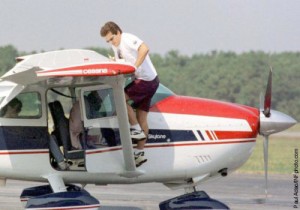
John F. Kennedy Jr. preflights a Cessna Skylane, presumably earlier in his flight training. The aircraft in which he would perish was a Piper Saratoga, a low-wing aircraft with retractable gear. Courtesy: Zimbio.com
The vast majority of aircraft accidents, including fatalities are the result of pilot error. The leading sub-cause is “continued flight into known Instrument Meteorological Conditions (IMC) resulting in spatial disorientation”.
A famous example is John F. Kennedy Jr., who actually was flying legally in Visual Meteorological Conditions (VMC), but they were marginal due to very thick summer haze near the end of sunset, over water east of Long Island.
What happened? Even in thick haze, flying over land, its still easy to have a horizon reference that helps your brain tell you your’re upright. Over the water that reference is severely diminished at night. This leaves your vestibular sense or “inner ear” as the only thing telling your brain which way is up. This sense does a poor job without its friend, your peripheral vision which senses the earth’s horizon.
JFK Jr. was pressed for time, trying to make a wedding on Martha’s Vineyard. In the months prior he had been training to earn an instrument rating but was not there yet and his interpretive skills of the aircraft instruments were still developing.
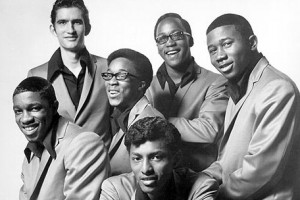
The Bar-Kays. (From L to R: Ben Cauley, Ronnie Caldwell, Carl Cunningham, Jimmie Kelly, and James Alexander. Phalen Jones is seated below.) Cauley was the sole survivor of the crash. Alexander flew by airline.
While technically legal VMC existed, Kennedy flew in conditions that were beyond his abilities and he got spatially disoriented. The smooth air during his initial descent likely diminished the warnings that he had entered a slow bank.
By the time he noticed what was happening, his first control input to fix it was probably the wrong one. His reaction could have exacerbated the condition and he likely entered a graveyard spiral, which is a typical scenario.
Instrument rated pilots have solidified their skills and if they use them regularly the JFK Jr. situation rarely happens or at least doesn’t become unsafe. We teach pilots to only fly to their practiced abilities. We tell them just because its legal doesn’t mean its safe.
Personal Personalized Plane
Otis Redding was 26 when he and six others including the pilot, Redding’s manager, and members of his backing band the Bar-Kays died in the cold waters of Lake Monona. Only Bar-Kays member Ben Cauley survived and he couldn’t even swim. A 6th member of the band traveled by airline from their last stop since the aircraft could only hold seven passengers.
The plane they were flying was a Beechcraft 18, a World War II era twin-engine passenger and cargo aircraft. The aircraft was a very reliable performer for the military who flew them until 1976. While this aircraft may have seemed outdated to some, this type is still in use today, mostly by cargo operators and one aerobatic pilot.
I can’t speak to the maintenance record of Otis Redding’s plane, which he owned and featured Redding monikers emblazoned on its outer skin. The only maintenance issue known initially was what Ben Cauley overheard a mechanic discussing in Cleveland, where they departed, about a partially charged battery.
The battery likely had nothing to do with the crash. The battery is used for engine starting and emergency power. Once the engine starts it turns a generator which supplies electrical power to aircraft system and recharges the battery.
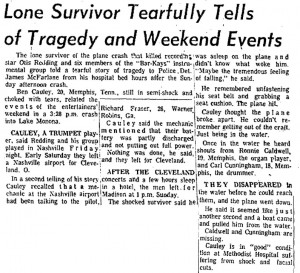
Each engine has a generator so even if one failed the other can easily pick up the slack. A dual generator failure would then put the battery back into play, but this case happens more in the movies than real life.
Weak batteries are not a grave safety risk but they should be addressed soon since it should be fully charged in case of emergency.
It simply could have been an older battery that wasn’t holding a full charge and the mechanic was wondering if it had enough to start the aircraft, or would it need a jump.
Training and technology is a dancer
Even in those days planes didn’t just fall out of the sky, its often due to a chain of reasons that are usually preventable. While pilot error usually is the cause, there have been mechanical issues that a pilot can’t overcome. However a more typical scenario is that a small manageable mechanical, weather, or outside issue distracts the pilot or crew to a point that it unnecessarily becomes an emergency.
To combat this the Aviation industry developed Cockpit Resource Management (CRM) which is basically a fancy name for teamwork. However it did not become widely adopted in the airline pilot ranks until the 1980s.
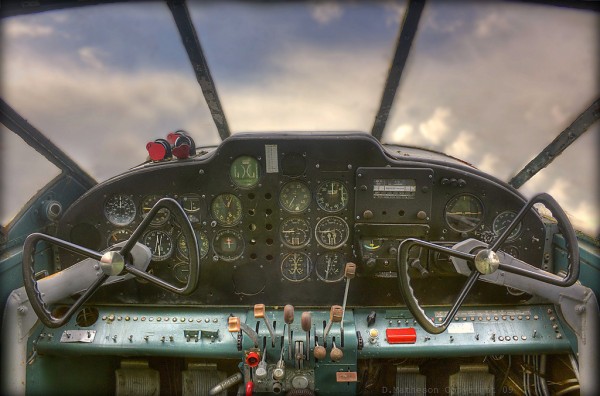
The cockpit of a Beech 18. The instrument partially hidden by the top right corner of the left side yolk is similar to what was used to fly the approach into Madison.
Before then the “Captain” was more of a macho ego-driven position on the plane and that sometimes led to accidents. In some cases the First Officer may or may not have had enough courage to challenge the authority of the person in the left seat, even when he was leading them to disaster.
In the corporate and charter flying world, CRM took even longer to be adopted partially due to the fact that half of these “planes for hire” can be operated “single pilot”. Redding’s Beech 18 has two pilot seats (Cauley said Redding was sitting up front with the pilot-a normal and perfectly safe practice) but could legally be operated single pilot. However, just because there is only one pilot does not make it less safe.
Safe or not it took longer for the industry to develop and market CRM techniques for the single pilot whether they were professionals or private flyers in their own planes. Now both education and technology along with a generation of pilots who have only known a world with CRM has arguably made general aviation just as safe.
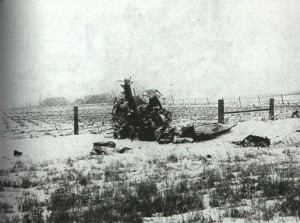
The four-seat aircraft that carried Buddy Holly, J.P. Richardson, and Ritchie Valens did not make it very far from the airport after encountering a snowstorm at night.
Another difference between now and then was the technology available to pilots and air traffic controllers. Navigation, radar, traffic collision avoidance, training, and reliable instrumentation have all greatly improved.
Weather reporting, forecasting accuracy, and accessibility have also improved greatly meaning pilots can make better strategic and tactical decisions.
When J.P. Richardson, Buddy Holly, and Ritchie Valens crashed shortly after takeoff in Iowa in February 1959 it was due to a freak snow storm. At that time pilots did just as well to look at the sky as they would reading the weather reports.
Weather Radar did not enjoy nationwide coverage until 1980 but even at that early stage that snowstorm would have been spotted. Now, if properly equipped, weather radar can be delivered directly to the aircraft via satellite.
The small little white hut
On the corner of Winnequah Road and Wyldhaven Avenue in Monona just on the west side of Winnequah Park is an open lot with a fenced-in white building with a V-shaped antenna. At two corners of the fenced area are two short telephone poles with a wire that angles down toward the antenna. An ominous sign warns about no trespassing on this federal facility.
This little white hut houses an air navigation beacon called an Outer Marker which marks the beginning of the instrument approach to Runway 36 (north runway) at the Dane County Regional airport. When I started learning to fly in 1990 that beacon was named MONAH (probably for lake Monona), featured both AM and VHF radio beacons, the latter is part of the Instrument Landing System (ILS) which was likely in place in 1967.

An overhead look of how planes approach Runway 36. The red dot is outer marker also known as the final approach fix or the beginning of the final stage of the approach. Based on all the known evidence, Robert Fraser began the approach normally but soon lost control.
The ILS gives both vertical and lateral guidance toward the runway by broadcasting radio signals that are received and displayed through a single instrument in the cockpit. The localizer is the lateral or left and right guidance, the “glideslope” gives vertical guidance.
When aircraft cross the outer marker they are approximately 2,000 feet above the ground and 4 miles from the beginning of the runway. According to newspaper reports in the Wisconsin State Journal, the control tower cleared pilot Richard Fraser, 26, for the approach at 3:25 p.m. At this moment his exact position is unknown since aircraft in the Madison area at that time were not separated by traffic control radar, but rather by time and position reports.
Another unidentified media report from the time said the visibility was three miles but the cloud ceiling was 100 feet. The Wisconsin State Journal quoted a control tower supervisor who said that light drizzle and fog existed at the time of the crash but still good enough for an instrument approach. It should be noted that while the approach is flown on instruments, the landing is always visual.
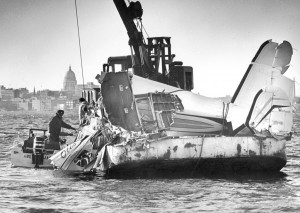
Wreckage of the plane that was carrying Otis Redding and his band is recovered from Lake Monona. Courtesy: Dipity.com
Minutes after the approach clearance was given residents along the 4600 block of Tonywatha Trail in Monona would witness Redding’s plane “splash” into the lake.
The location of the crash is about one half mile off shore and about one half mile north of the outer marker on a straight line directly to Runway 36.
“From the sound of it we knew something was wrong with the airplane,” eyewitness Chris Dickert, then 21, told the website No Depression several years ago.
“Through the haze we saw something break through the cloud and we watched it fall until it hit the water right in the middle of the lake.”
Dickert said he was watching a football game with his Dad when he heard the familiar sound of a plane overhead, yet it sounded in distress, the engine cutting in and out. Because the conditions were foggy and sometimes rainy; at that particular temperature the engines could be susceptible to carburetor ice. Even so, the aircraft has systems to fight that, and there are two engines which means the pilot should be able to complete the approach on just one; we’re trained to do that.
“…the tremendous feeling of falling”
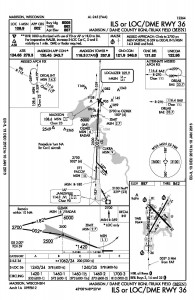
The ILS approach chart for Runway 36 in Madison. This is the 2012 version but doesn’t vary greatly in basic format from the procedure in use in 1967.
Ben Cauley had been sleeping before the final minutes of the flight. He said that he awoke to “…a tremendous feeling of falling” and he felt like the plane was in a tailspin.
The fact that the aircraft was found laterally aligned with the runway centerline further puts in doubt mechanical failure or an instrument malfunction due to a weak battery as surmised in one of the media reports following the crash.
One key missing piece of information is what altitude was Fraser at when he began his approach. Crossing the outer marker, the glideslope acts like a really long stairway banister that ends at the runway. The glideslope gives you a 700 foot per minute descent rate and professional standards require you to “miss” the approach if that rate exceeds 1000 fpm.
If he was flying what is called a non-precision approach (sometimes called a localizer approach) where there was no glideslope or vertical guidance available due to an outage or the aircraft was not equipped to receive it; then Fraser would have been required to level off at a preset altitude while maintaining his course until he sees the airport.
If Fraser was too high he could have tried to “chase” the glideslope which would cause him to increase his rate of descent. Same with the non-precision approach where the goal is to get to Minimum Descent Altitude (MDA) quickly and safely to have more time to try and spot the airport. In trying to catch the glideslope or MDA the increased rate of descent may have contributed to his disorientation.

The OZMIX Outer Marker, formerly named MONAH, has been a quiet neighbor in Monona for years. Courtesy: Google
So could a sudden bout of carburetor ice which could have led to a balky engine(s). There is no doubt he was disoriented, the tailspin reported by Cauley confirms it. But none of these distractions should have caused Fraser to lose control.
Back to Josh Marshall’s list of 13 musicians that have been killed in small plane crashes in the past 50 years. Nine of those were killed in weather-related crashes mostly due to pilot disorientation. Four were killed due to fuel starvation, one due to an in-flight cabin fire which was poorly managed by the flight crew and one due to severe aircraft overloading. In all of the accidents, they were largely preventable.
Single Pilot Hubris
John Denver (included in the list above) died while flying low over the water just off the coast of California in a single-place single engine aircraft he had just purchased. It was an FAA approved amateur-built aircraft which people tend to focus on, but the reason Denver crashed was due to a lack of preflight planning and training in the aircraft.
Denver, who had loads of flying experience including jet aircraft, departed with too little fuel. When a fuel tank went dry he had trouble switching tanks because the valve was located in an unorthodox place in the cockpit. In reaching for the fuel valve he caused his leg to kick the rudder pedal which hastily pointed his aircraft toward the ocean.
Should Denver have been flying an unfamiliar plane so low over the water thus leaving him few options should there be a problem? Probably not. Through all the tragic accidents discussed above a common theme emerges: Pilots and their decisions were or likely were the cause of these accidents.
The Aviation industry has done a great job engineering away most mechanical factors in accidents, but there will always be some. But that still leaves the human factor as the major contributor.
Josh Marshall gets it mostly right in that the other causal factors which include poor training, “ignoring bad weather”, outside pressures such as tour schedules; all reasons which often cause pilots to compromise their limits and go against the judgement that has kept them alive up to that point. But he poisons his observation by also blaming “small and unreliable planes”.
At a recent dinner party I was asked by a nervous flyer about how skilled pilots really are. I explained to her that we are very fortunate in 2012 because the aviation tradition in the U.S., building since 1903, has begat the best training and industry practices in the world. Thus every plane crash is a news event because it’s truly a rare bird.
I may have thrown pilots “under the bus” a bit, but it was to prove a point: Small planes don’t kill people, certainly not beloved musicians.
Appendix:
Here are the actual causes of the crashes on Josh Marshall’s list with layman summation and paraphrasing by me:
Otis Redding: NTSB: Undetermined. Likely spatial disorientation due to the reasons stated above.
Buddy Holly, Richie Valens, and J.P. Richardson ‘The Big Bopper’: “…pilot’s unwise decision to embark on a flight which would necessitate flying solely by instruments when he was not properly certificated or qualified to do so. Contributing factors were serious deficiencies in the weather briefing, and the pilot’s unfamiliarity with the instrument which determines the attitude of the aircraft.” – Civil Aeronautics Board
Stevie Ray Vaughan: Helicopter crash into a ski hill during a night flight in low visibility and fog.
Patsy Cline: Pilot pressed on through an unstable weather pattern including thunderstorms.
Jim Croce: Pilot failed to maintain obstacle clearance during departure at night in low visibility and fog.
Ricky Nelson: In-flight cabin fire leads to crash. Flight crew used poor CRM in dealing with fire.
Aaliyah: Crash on takeoff due to severe aircraft overloading and an aft center-of-gravity condition.
John Denver: Failure to maintain aircraft control during fuel starvation situation.
Half of Lynyrd Skynyrd: Fuel starvation.


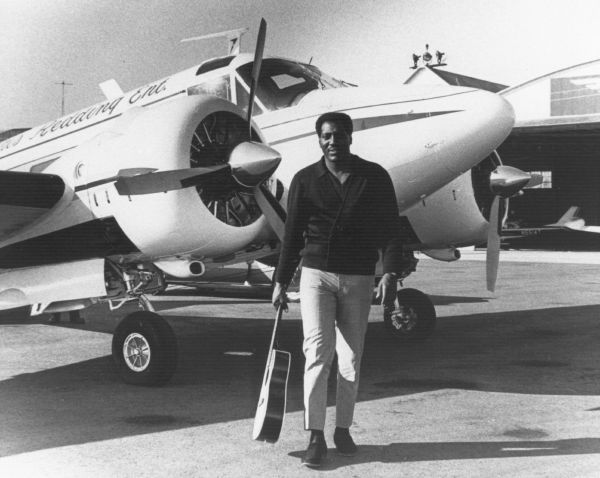
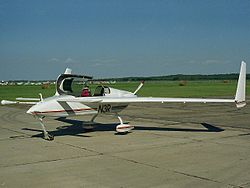
Thanks; I’ve been wondering about this for years, since I noticed how many musicians had died in small-plane crashes…
While planes are not blameless, categorically small planes have been looked down on by the general public; spurred on by breathless Hollywood portrayals and lazy journalists that never take the time to understand how safe aircraft really are. Airplanes cost so much partially due to lawsuits because grieving families will go to great lengths to find some mechanical fault when in most cases, the person flying the plane shoulders most of the blame.
Thanks so much for this – I will pass it on to my daughter Elena – she was learning to fly around the same time you were – and gave me the same explanation about JFK Jr – I recently read an interesting book about the death of Paul Wellstone – there have been many dubious deaths of politicians in small planes – the official explanation of the Wellstone crash was pilot error – but the book suggests otherwise.
What is the name of that book? It would be hard to prove anything else besides pilot error. I also knew some people who knew the pilot in command, he was a marginal pilot at best and had a very inexperienced co-pilot. Plus, after reading the NTSB report, it was a simple case of the flight crew not flying the approach properly and spending too long in icing conditions. Plus, the push of a campaign schedule may have been in the back of the flight crew’s mind
This accident speaks to the thrust of my argument…another preventable accident.
Hey man,
Enjoyed the article very much. Thanks.
I would caution, however, that dead men tell no tales, and if there were a rational explanation for crashes BESIDES pilot error, well, sometimes those reasons die with the pilot(s).
Therefore, I would personally be reticent to disparage dead people who can’t defend themselves, you know what I’m saying?
I mean, even inexperienced people can be diligent and focused but just lose the game due to circumstances. Sometimes, “newer” pilots are even more focused and mindful of procedure, while some veterans can get cocky and cut corners. It in other areas of life, so I’m sure it happens with pilots too.
For instance, when I first started driving a car, I was hyper-aware of every minute input I gave to the steering wheel. Now, it’s second-nature, so I’m more likely to mess with the radio or eat while driving, or something like that. I used to work for an airline as a teen in the 1980’s, and would marvel at the number of “experienced” pilots who showed up to work wreaking of alcohol. New pilots never did so. So, experience brings it’s own set of issue.
Calling someone a “marginal” pilot after their death is a subjective accusation, and one that cannot be rebutted. As such, it’s possibly a touch cowardly, although I know that was not your intention. I mean, if there was a factor you didn’t know about, then maybe placing the blame on a dead guy is, well, convenient I suppose. Or maybe it was 100% his fault. If that’s the case, well, he paid for his imperfections, which is more than most of us can say. Once that happens, at least in my opinion, the decent thing to do is to treat them with respect. There are few of us, if any, that are as together as we thing we are, and few of us, if any, can live up to the standards to which we hold others. Human nature.
Anyway, food for thought, and again, thanks for the article. Very informative.
REX, everything you said in your reply is beautifully stated. I couldn’t have said it better. Thank you.
.This is our summary:
….. “There are FEW of us, if any, that are as together as we THINK we are, and FEW of us, if any, can live up to the STANDARDS to which WE HOLD OTHERS.
(That’s) “human nature.”
*******
As much as I would like to be a perfectionist, I know there are limittations.. God set them.
REX,
in my above comment, I meant to say,,
……. “this is YOUR summary” ……..
F. B.
Really – that’s the dumbest think I’ll hear for a week – “can’t talk about dead people” who shall pontificate the crickets ? shhh no talk -their dead – ?
Sorry, Josh Marshall was right. In a larger plane, Denver might have have more room to access the fuel switch. Small aircraft are dangerous and more susceptible to pilot error due to interior and exterior spacial limitations. This a no brainer.
Space limitations? I’ve never been in a small plane that was more dangerous because of space limitations. As a matter of fact, everything is within arm’s length and couldn’t be more efficient. In addition, the smart designer clusters everything….engine-related stuff here… avionics related stuff there… navigation stuff over here. Simple.
The notion that it’s a no brainer that Denver died because of space limitation is without any foundation or likely knowledge of a small airplane.
Denver died for reasons lots of pilots died. He was arrogant and didn’t think he needed transition training in a new airplane.
Richard Collins — Google him — has fairly well shown that most small airplane crashes seem to occur in the first 100 hours of a pilot’s exposure to a new aircraft regardless of total time of the pilot involved.
Airplanes, regardless of their size, power or configuration have absolutely no idea of whether it’s nigh or day, hot or cold or what conditions are present. It has no soul, does not care about its pilot(s) or passengers and will kill with extreme prejudice if flown outside of operating limitations, or out or above the skill level of the pilot. I was told early in my flight training in the early seventies that the operational limitations of any aircraft have been well documented and are not suggestions… They are rock solid data that you can “hang your hat on”. To exceed these limitations, by even a pound over max gross weight, a mile per hour of Max airspeed, instantly transforms one into a Test Pilot. Consequently, the FAA publishes that the pilot in command is ultimately responsible for the final authority of the aircraft. A Huge responsibility in one’s hands, especially with passengers on board… Barry Colley
Just finished the latest Otis Redding Bio (Dreams to remember) 2015 Mark Ribowsky which pretty much echo’s the facts that are accepted as the possible cause for crash. I am not a pilot but I Have a question ? Ben Cauley made no reference to any hysterics in the cockpit when he woke up. As you stated a small problem can be compounded into a dire situation. I may have just answered my own question. At the first sign of trouble, well you can just imagine !
Yes Doug this is a major factor. Even if people don’t want to talk about it.. I feel stupid. Goodbye !
April 14 1865/ 1912 Lincoln Killed. Titanic started to sink. She did the next morning… Who knows there history ? I would bet Berry does. So what do you think is important when you raise a kid ? What do they need to know ? COMMON SENSE.. If you have a good common sense, what other life lessons do you need ? Buddy Holly Syndrome – take the buss dude..
Have I said something wrong ?
Rick, the fuel valve was over his left shoulder. Why take off on an empty tank?
I have heard that the pilot of the Jim Croce plane may have had a heatatack. has that ever been proved. you left off one othe plane crash, Jim Reeves. have recently read he was not really certified to fly the one he died in.
In the late 60’s, I was producing concerts on Jekyll Island, GA and one of the shows included Otis Redding, the Bar-Kays, Arthur Conley, etc.
Otis arrived late and I was called to pick him up at the small dirt strip airport on Jekyll Island. His Beechcraft started its approach but, just before touching down, pulled up abruptly and went around for another pass before landing.
Otis got off the plane visably shaken and I met him and intoduced myself. As we walked towards my car, I asked if he was OK and what happened with the unusual landing. He said, “George, the pilot has Air On The Brain. Sometimes if he comes down too fast, he gets dizzy and has to go back up and try again”.
When he died in the crash a few months later, I remembered those words and looked up that condition which is called venous air embolism.
I have wanted to share this information with someone for 50 years and you seem like the right person.
George Cook
It’s very sad to think that we lost so much talent over the years because of small airplanes and helocopters just to get to the next gig faster … Most all of these could have been prevented too just don’t seem right .
I am a 4500 hour pilot. I am also a musician. John Denver never took the time to learn where the fuel transfer valve was and if he could reach it.
As to Otis and Aleshia, these are powerful people with “gottogetthere” ITIS.
The hardest thing to tell the “BOSS” is we can’t do it. I will cost you your job, but at least you will still be alive. People overfill aircraft with way too much stuff and put it in that back were it becomes deadly due to “weight & balance”. If your a pilot the problem and pitfalls. If you not it like a Chevy Wagon. There’s a space? There room for something else. I once was flying back from Florida to Conn. I told my son to put a relatively have bag in the nose baggage compartment. He was to lazy so he hid it in the back of the aft baggage compartment. I had severe trim issue on that flight. I took care of it but some might not have been as capable. IF you load up an twin engine aircraft and you lose an enginer the plane is suppose to fly on just one. It might be able to climb 200 ft a minute vs 1000 ft a minute. You are flying at 100mph so to get to 500 ft if it dies on takeoff it will take you over 5 miles of land! In Otis’s case a Beech 18 is ornery to begin with. Overloaded as I am sure it was but come a real bitch. You’ve lowered your aircraft to approach speed and have gone over the outer marker. You have a shit load of trim in just to hold it and something happen! Your low, your slow and in the clouds. Been there, done that and it ain’t fun, until it’s done.
Finally, the DC3 that Rick Nelson was flying in with all the bullshit about him smoking crack in the back of the plane and such. ALL BULLSHIT. The DC-3 had a gas heater in the back of the plane. All twin engine aircraft have one as there is no way to flow heat from a manifold to the cabin like a single engine aircraft. Rich and his guys were freezing their balls off as the heater kept popping the circuit breaker. So the pilot or co pilot in their supreme wisdom duck taped the circuit breaker down. Didn’t blow no more, when it tried to it would start a fire and by the time the pilots knew, it was all but over. If you had screw in fuses in you house and the fuse popped you changed it. If it popped again, you called an electrification to find out what was wrong. .If you were cheap or stupid you put a penny in and screwed the fues back in. You had power right up to the fire that started afterwards.
I am not a pilot just an aviation enthusiast. I follow Kathryn’s Report, The Aviation Safety Report and NTSB accident database. I do not know if it is out of morbid curiosity. Maybe it is to try to comprehend the mistakes made and to learn from them if I ever get the opportunity to earn a pilot’s license.
I am a musician too. The music of Jim Croce and John Denver and the magical voice of Jim Reeves were among my favorite singers and musicians. I have read all their NTSB reports including all those mentioned here.
I was talking to my house mate tonight. He says there is an Apple app that he uses that has an altimeter and horizontal orientation system.. These apps are new and were not available back in the day that most of these airplane crashes happen. I still maintain that even with these app one needs to be trained until it becomes second nature when dealing with IMC conditions.
Though this example does not speak directly to your article today I think it proves my point that just because you may play with Flight Sim applications when the reality of landing an airplane without proper training than attempting landings you could turn into a test pilot.. I am speaking about the cargo handler from Sea-Tac airport who stole a plane and took an unauthorized flight through Sea-Tac airspace which ultimately led to his death and destruction of the airplane. I suspect that multiple hours of just flying VFR is required before you can get your instrument rating. It then requires hours of instrument training before you can earn that rating. But even instrument rated pilots have been killed in IMC condition because they fail to practice the principles to maintain that efficiency.
Finally I agree that flying a small general aviation plane is as safe as the hands that holds the pilot stick. I think the same argument is true in the current gun laws debate. No gun is capable of firing itself. It requires the interaction of the gun with a human interface. Just like a plane. Smart decision making using both of the instruments can be difference in life and death of all.
Poor Otis dead and gone, left me here to sing this song
Nice job! Thanks for sharing your thoughts on these accidents. I think you hit the nail on the head squarely.
Its always hard to look and read of death due to plane crashes but, I feel when the cause is down to the pilot its harder as they should’ve been trained/prepared/alert to the situation around them at the time of the crash. However they did not want to die either so RIP All.